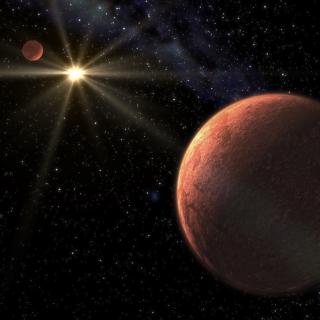Bibcode
Trifonov, T.; Lee, M. H.; Kürster, M.; Henning, Th.; Grishin, E.; Stock, S.; Tjoa, J.; Caballero, J. A.; Wong, K. H.; Bauer, F. F.; Quirrenbach, A.; Zechmeister, M.; Ribas, I.; Reffert, S.; Reiners, A.; Amado, P. J.; Kossakowski, D.; Azzaro, M.; Béjar, V. J. S.; Cortés-Contreras, M.; Dreizler, S.; Hatzes, A. P.; Jeffers, S. V.; Kaminski, A.; Lafarga, M.; Montes, D.; Morales, J. C.; Pavlov, A.; Rodríguez-López, C.; Schmitt, J. H. M. M.; Solano, E.; Barnes, R.
Bibliographical reference
Astronomy and Astrophysics
Advertised on:
6
2020
Journal
Citations
24
Refereed citations
21
Description
Context. GJ 1148 is an M-dwarf star hosting a planetary system composed of two Saturn-mass planets in eccentric orbits with periods of 41.38 and 532.02 days.
Aims: We reanalyze the orbital configuration and dynamics of the GJ 1148 multi-planetary system based on new precise radial velocity measurements taken with CARMENES.
Methods: We combined new and archival precise Doppler measurements from CARMENES with those available from HIRES for GJ 1148 and modeled these data with a self-consistent dynamical model. We studied the orbital dynamics of the system using the secular theory and direct N-body integrations. The prospects of potentially habitable moons around GJ 1148 b were examined.
Results: The refined dynamical analyses show that the GJ 1148 system is long-term stable in a large phase-space of orbital parameters with an orbital configuration suggesting apsidal alignment, but not in any particular high-order mean-motion resonant commensurability. GJ 1148 b orbits inside the optimistic habitable zone (HZ). We find only a narrow stability region around the planet where exomoons can exist. However, in this stable region exomoons exhibit quick orbital decay due to tidal interaction with the planet.
Conclusions: The GJ 1148 planetary system is a very rare M-dwarf planetary system consisting of a pair of gas giants, the inner of which resides in the HZ. We conclude that habitable exomoons around GJ 1148 b are very unlikely to exist.
Aims: We reanalyze the orbital configuration and dynamics of the GJ 1148 multi-planetary system based on new precise radial velocity measurements taken with CARMENES.
Methods: We combined new and archival precise Doppler measurements from CARMENES with those available from HIRES for GJ 1148 and modeled these data with a self-consistent dynamical model. We studied the orbital dynamics of the system using the secular theory and direct N-body integrations. The prospects of potentially habitable moons around GJ 1148 b were examined.
Results: The refined dynamical analyses show that the GJ 1148 system is long-term stable in a large phase-space of orbital parameters with an orbital configuration suggesting apsidal alignment, but not in any particular high-order mean-motion resonant commensurability. GJ 1148 b orbits inside the optimistic habitable zone (HZ). We find only a narrow stability region around the planet where exomoons can exist. However, in this stable region exomoons exhibit quick orbital decay due to tidal interaction with the planet.
Conclusions: The GJ 1148 planetary system is a very rare M-dwarf planetary system consisting of a pair of gas giants, the inner of which resides in the HZ. We conclude that habitable exomoons around GJ 1148 b are very unlikely to exist.
Related projects

Very Low Mass Stars, Brown Dwarfs and Planets
Our goal is to study the processes that lead to the formation of low mass stars, brown dwarfs and planets and to characterize the physical properties of these objects in various evolutionary stages. Low mass stars and brown dwarfs are likely the most numerous type of objects in our Galaxy but due to their low intrinsic luminosity they are not so
Rafael
Rebolo López

Exoplanets and Astrobiology
The search for life in the universe has been driven by recent discoveries of planets around other stars (known as exoplanets), becoming one of the most active fields in modern astrophysics. The growing number of new exoplanets discovered in recent years and the recent advance on the study of their atmospheres are not only providing new valuable
Enric
Pallé Bago